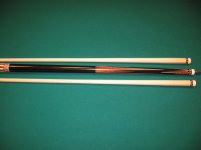I assume coring is done for controling weight and balance. Is this a common practice? Are cue makers divided on this practice as like never not me or sometimes if necessary. I know it's subjective but just spoke with a guy that says hell no, won't play right etc. Sounds like it would actually require more work to do so. Just curious. Are there some big time makers who always, sometimes or never core their cues?
You are using an out of date browser. It may not display this or other websites correctly.
You should upgrade or use an alternative browser.
You should upgrade or use an alternative browser.
Coring
- Thread starter Mr. Wiggles
- Start date
I core for stability , hit and to add weight by not using bolts.
It is more work.
It is more work.
I core for stability , hit and to add weight by not using bolts.
It is more work.
I do it for the same reasons and to basically eliminate the A-joint as I also do on my 6-pie laminated butts. And as for the "it won't play right" - bull.
Bob Danielson
www.bdcuesandcomix.com
What do you mean eliminate the A joint ? as in one piece cored butt ?
I do it for the same reasons and to basically eliminate the A-joint as I also do on my 6-pie laminated butts. And as for the "it won't play right" - bull.
Bob Danielson
www.bdcuesandcomix.com
I assume coring is done for controling weight and balance. Is this a common practice? Are cue makers divided on this practice as like never not me or sometimes if necessary. I know it's subjective but just spoke with a guy that says hell no, won't play right etc. Sounds like it would actually require more work to do so. Just curious. Are there some big time makers who always, sometimes or never core their cues?
In my opinion do to the wood used when building some woods almost always should be cored for stability. Birdseye Maple is such a wood just as an example, now coring Birdseye will depend upon the grain and figure. If the wood is just sick with figure and eye's the grain will be very wavy and it can fracture in some cases with little abuse. I have seen a number cues over the year's break just below joint from simply being drop and hitting the ground at angle that caused the shaft and but to flex. In some cases I have seen the bottom of the pin was exposed in others they split much farther down the forearm.
However, in all cases I am speaking about there were no impact marks and the wood fractured along the non-straight grain. I suspect that not coring when dealing with certain types of wood like I have outlined is like playing Russian Roulette, you never no when the chamber is loaded or when you are going to have a dry fire.
On a personal note I only core when I am concerned about these factors, however, when something is cored all stress within the wood is relieved and that section should never warp, and by coring with certain woods it is easier to make the cue hit more repeatable. Also like you said above coring a cue will allow for weight control, and pin point balance of a cue, but there are others methods that can also be used effectively. So some cue makers core all their cues, some core certain types of wood, and some will not core anything, I suspect that it is personal preference and the amount risk you are willing to take.
JIMO
In my opinion do to the wood used when building some woods almost always should be cored for stability. Birdseye Maple is such a wood just as an example, now coring Birdseye will depend upon the grain and figure. If the wood is just sick with figure and eye's the grain will be very wavy and it can fracture in some cases with little abuse. I have seen a number cues over the year's break just below joint from simply being drop and hitting the ground at angle that caused the shaft and but to flex. In some cases I have seen the bottom of the pin was exposed in others they split much farther down the forearm.
However, in all cases I am speaking about there were no impact marks and the wood fractured along the non-straight grain. I suspect that not coring when dealing with certain types of wood like I have outlined is like playing Russian Roulette, you never no when the chamber is loaded or when you are going to have a dry fire.
On a personal note I only core when I am concerned about these factors, however, when something is cored all stress within the wood is relieved and that section should never warp, and by coring with certain woods it is easier to make the cue hit more repeatable. Also like you said above coring a cue will allow for weight control, and pin point balance of a cue, but there are others methods that can also be used effectively. So some cue makers core all their cues, some core certain types of wood, and some will not core anything, I suspect that it is personal preference and the amount risk you are willing to take.
JIMO
ding ding ding
And by coring, if the wood on the outside swells up due to humidity, and the core did not, the cue is still for all intents and purposes, straight.
I do it for the same reasons and to basically eliminate the A-joint as I also do on my 6-pie laminated butts. And as for the "it won't play right" - bull.
Bob Danielson
www.bdcuesandcomix.com
Hi,
I am of the same school of thought as Bob about eliminating the A-Joint on my 5 point veneered cues. I install weight pins behind my joint pin and have a weight pocket in the butt so that I can attain any weight and balance envelope I wish just before installing the pin. I still use the A-Joint on my 4 pointers as the geometry goes too close to the center of the core, Since I like wide points it is a trade off and I am too lazy to reindex and glue in the points early. I am making less 4 pointers these days.
Rick
5 Point Geometry built on a cored forearm glued to a 29" one piece dowel with no A-Joint. With a 5 point geometry I am able to obtain a repeatable .025 gap between the veneers at the bottom of the point section.

Before turning down the taper to remove the excess point and veneer material the cutter grooves are filled with epoxy. With the 5 point geometry there is no structural instability when facing the A-Joint area and turning the taper. (Tulip wood cue is 5 point, other 2 on left are 4 point with A-Joints)
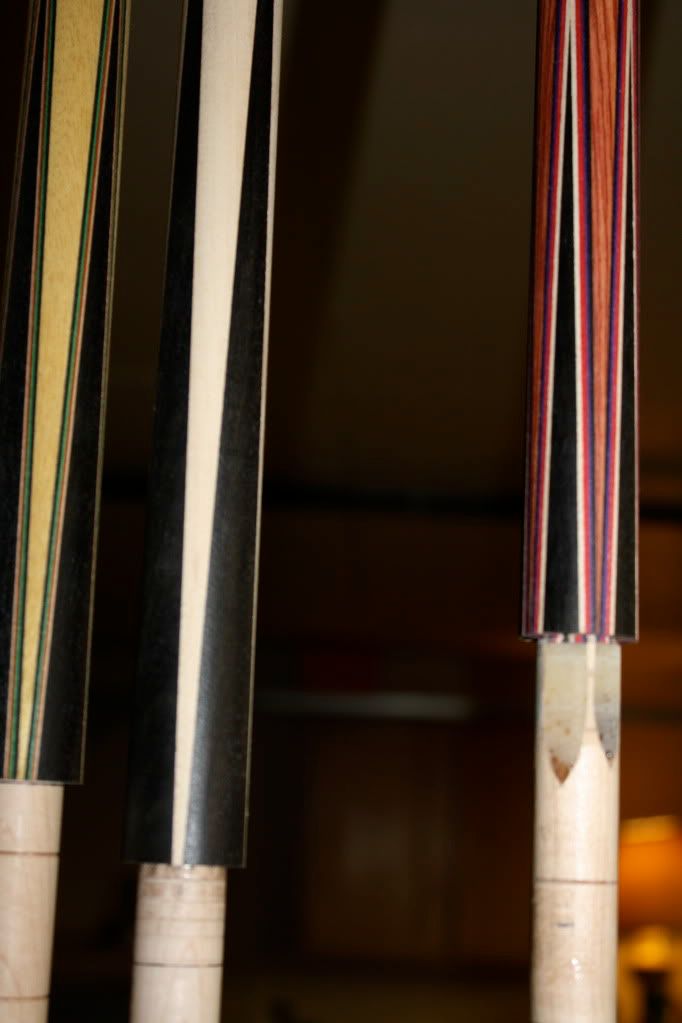
The 5 point cues at the 12" area reveals a gap between the point veneers is a repeatable .025 gap due. A 14.5 inch forearm is is used to create the stability to produces this small gap at the bottom. After installing the points and turing the 2.5 off, the forearm is faceed at the 12" dimension.
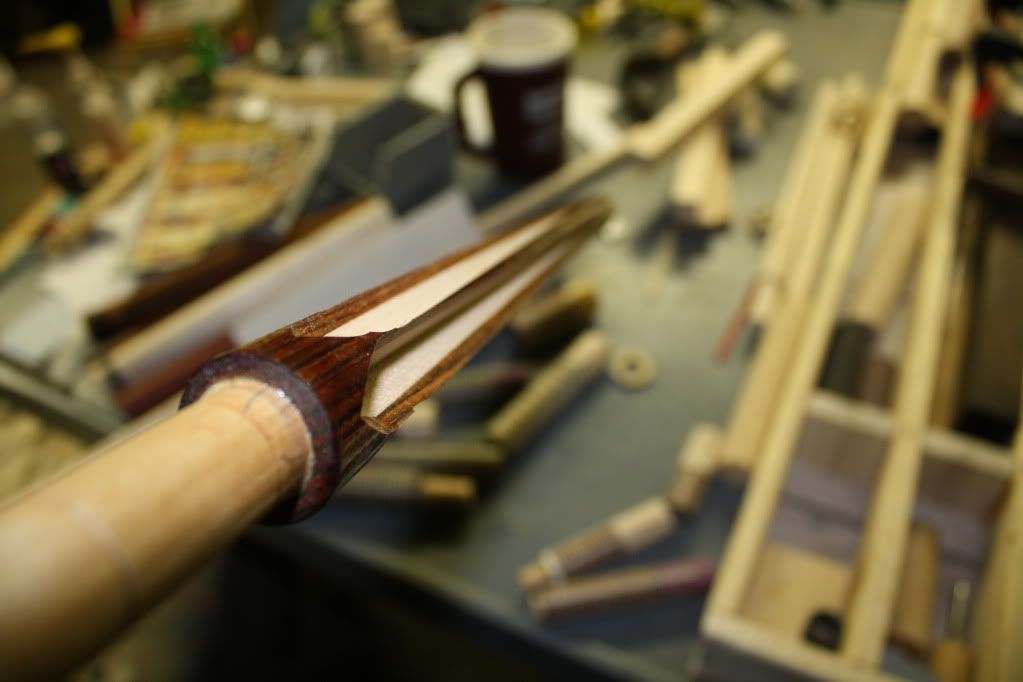
Without glueing in the points and reindexing and cutting grooves in a second milling operation I can not get the .025 gap on the 4 pointers. An .080 gap is seen between the veneers here because 4 point cue geometry would threaten the centerline of the core if I go too deep making it unstable for turning and facing. We use a traditional A-Joint connection with a 19" dowel screwed and glued to a previously cored forearm. Cutting the groves, gluing the point veneers, and reindexing on the milling table is one way of perform the the 4 point geometry on the full core with the stability to face and turn afterword but at some point in time economics and hourly labor cost become a huge factor.
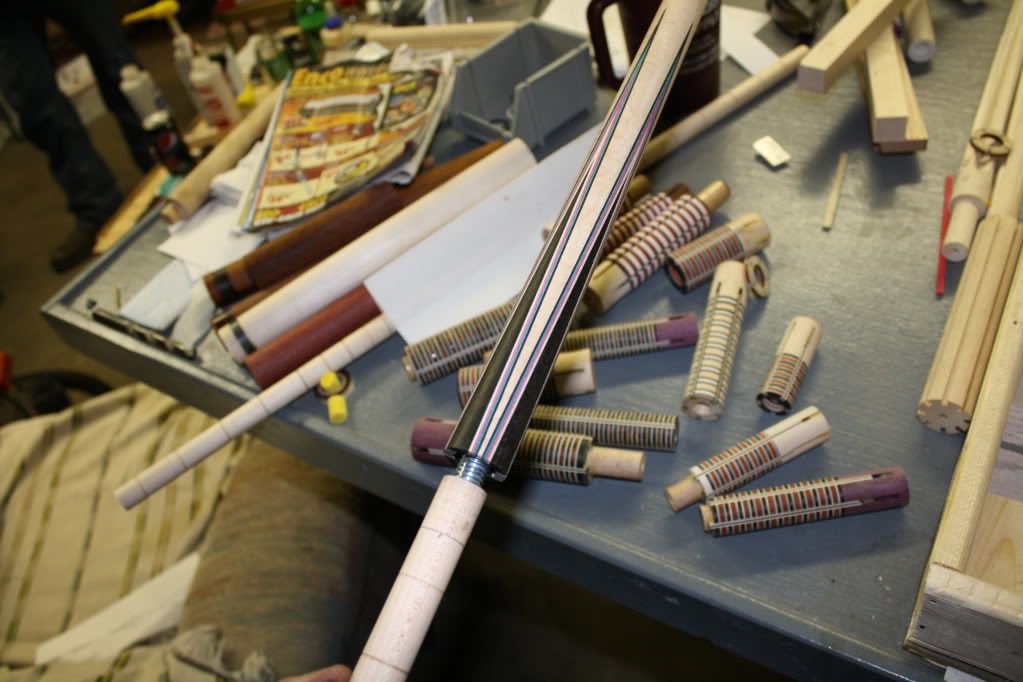
Traditional A-Joint section.
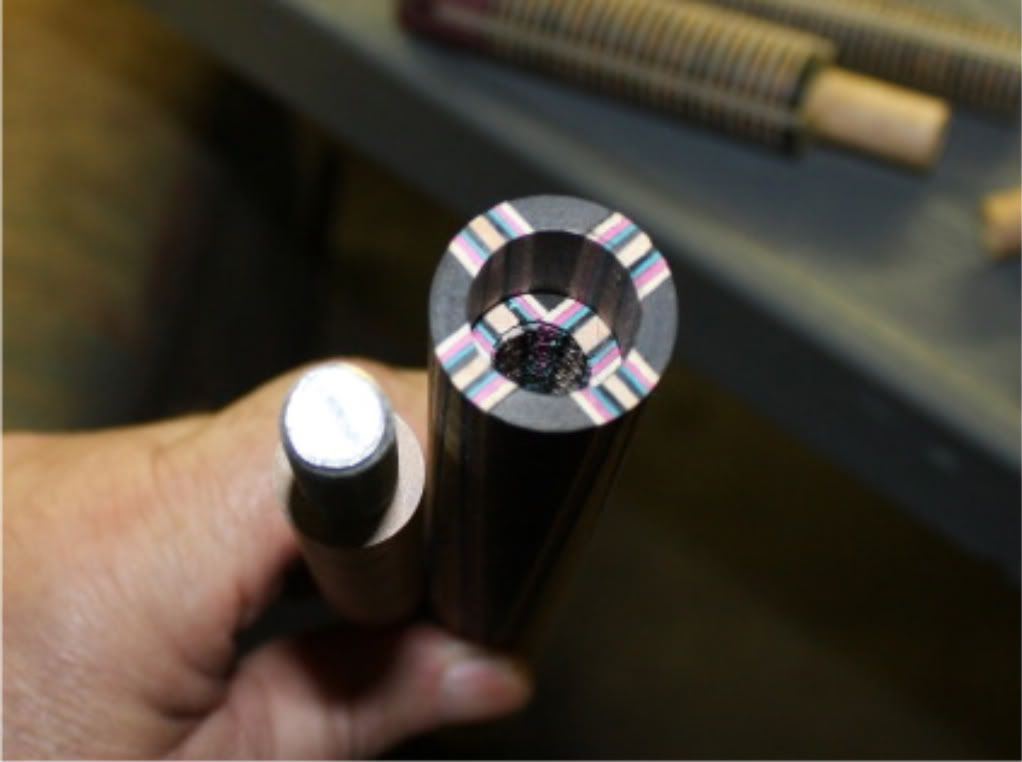
I have been coring my cues exclusively for the last 3 years and have beta tested many cues in the field. I have not had one cue develop a bump or produce any adverse buzz effect of any kind. I absolutely love Gorilla Glue and it's properties for cue making.!!!!!
Last edited:
I will say first that I core every cue. The wood for the core depends on the wood for the forearm and also the handle as sometimes I use something other that maple. By using different types of wood for cores it lets me balance the cue better, I also have a more repeatable feel in my cues. I will use straight grain maple ( solid), purple heart, rosewood and laminated maple cores.
Of course the cue is much more stable and much less prone to warping due to moisture or heat etc. It is more work for certain but I find it is well worth the extra effort after hitting a ball with a finished cue:grin:
Of course the cue is much more stable and much less prone to warping due to moisture or heat etc. It is more work for certain but I find it is well worth the extra effort after hitting a ball with a finished cue:grin:
Coring education
Thanks Joey, Manwon and dbcues. I think this az thing, being able to converse with cue makers, mechanics, players, sweaters and every aspect of pool is just about the coolest thing anyone could ask for in their quest for knowledge involving their passion for all things pool. Anyone thinking of purchasing cues, tables, instruction or anything would be remiss in their efforts to not take advantage of all this knowledge. Especially the purchase of a custom cue. I would encourage any buyer to spend many hours on these forums before finally calling the cue maker and beginning the process of building their cue. I am sure cue makers would appreciate this the most. I imagine they spend mucho time explaining all the intricacies of cue building to people that don't even purchase their cues. Do these guys a favor and become knowledgable before making that first contact!! Thanks again.
I core for stability , hit and to add weight by not using bolts.
It is more work.
Thanks Joey, Manwon and dbcues. I think this az thing, being able to converse with cue makers, mechanics, players, sweaters and every aspect of pool is just about the coolest thing anyone could ask for in their quest for knowledge involving their passion for all things pool. Anyone thinking of purchasing cues, tables, instruction or anything would be remiss in their efforts to not take advantage of all this knowledge. Especially the purchase of a custom cue. I would encourage any buyer to spend many hours on these forums before finally calling the cue maker and beginning the process of building their cue. I am sure cue makers would appreciate this the most. I imagine they spend mucho time explaining all the intricacies of cue building to people that don't even purchase their cues. Do these guys a favor and become knowledgable before making that first contact!! Thanks again.
What do you mean eliminate the A joint ? as in one piece cored butt ?
Yes, a 6-pie laminate 29" long core - no A-joint, but look like they have one. Else I make 6-pie full length butts of one or two types of wood, once again, no A-joint. Many are G-10 pins and no weight bolt in rear.
Bob Danielson
www.bdcuesandcomix.com
Attachments
Yes, a 6-pie laminate 29" long core - no A-joint, but look like they have one. Else I make 6-pie full length butts of one or two types of wood, once again, no A-joint. Many are G-10 pins and no weight bolt in rear.
Bob Danielson
www.bdcuesandcomix.com
Very Nice Cue Bob, I like totally agree with your concept.
Rick G
Originally Posted by bdcues View Post
Yes, a 6-pie laminate 29" long core - no A-joint, but look like they have one. Else I make 6-pie full length butts of one or two types of wood, once again, no A-joint. Many are G-10 pins and no weight bolt in rear.
Bob Danielson
www.bdcuesandcomix.com
Very Nice Cue Bob, I like totally agree with your concept.
Rick G
I AGREE EXCEPT I USE (MOSTLY) PURPLEHEART.
Yes, a 6-pie laminate 29" long core - no A-joint, but look like they have one. Else I make 6-pie full length butts of one or two types of wood, once again, no A-joint. Many are G-10 pins and no weight bolt in rear.
Bob Danielson
www.bdcuesandcomix.com
Very Nice Cue Bob, I like totally agree with your concept.
Rick G
I AGREE EXCEPT I USE (MOSTLY) PURPLEHEART.
Confused
I'm confused, so I've got 2 questions.
1- On the tulipwood forearm, are you sleeving a handle over the tenon and epoxy, or are you making a traditional A-Joint with that cue?
2- On the rosewood cue above, that looks like you'll put in the 5 points, then cut a flat face to the bottom of the points after filling the gap with epoxy. Correct?
Hi,
I am of the same school of thought as Bob about eliminating the A-Joint on my 5 point veneered cues. I install weight pins behind my joint pin and have a weight pocket in the butt so that I can attain any weight and balance envelope I wish just before installing the pin. I still use the A-Joint on my 4 pointers as the geometry goes too close to the center of the core, Since I like wide points it is a trade off and I am too lazy to reindex and glue in the points early. I am making less 4 pointers these days.
Rick
5 Point Geometry built on a cored forearm glued to a 29" one piece dowel with no A-Joint. With a 5 point geometry I am able to obtain a repeatable .025 gap between the veneers at the bottom of the point section.

Before turning down the taper to remove the excess point and veneer material the cutter grooves are filled with epoxy. With the 5 point geometry there is no structural instability when facing the A-Joint area and turning the taper.

The 5 point cues at the 12" area reveals a gap between the point veneers is a repeatable .025 gap due. A 14.5 inch forearm is is used to create the stability to produces this small gap at the bottom. After installing the points and turing the 2.5 off, the forearm is face at the 12" dimension.

I'm confused, so I've got 2 questions.
1- On the tulipwood forearm, are you sleeving a handle over the tenon and epoxy, or are you making a traditional A-Joint with that cue?
2- On the rosewood cue above, that looks like you'll put in the 5 points, then cut a flat face to the bottom of the points after filling the gap with epoxy. Correct?
I'm confused, so I've got 2 questions.
1- On the tulipwood forearm, are you sleeving a handle over the tenon and epoxy, or are you making a traditional A-Joint with that cue?
2- On the rosewood cue above, that looks like you'll put in the 5 points, then cut a flat face to the bottom of the points after filling the gap with epoxy. Correct?[/QUOTE]
Hi,
The Tulip cue forearm was cored at 1 3/8" and gorilla glued to the dowel, then tapered to .875 at the nose. After cutting the v grooves on the cored 14.5" forearm I glue in the veneered points. I fill in the end of the exposed v grooves with G-5 before I hold the dowel in the chuck and live center the nose and turn and face to 12".
The other cue shown is a full cored unit with the 5 V grooves cut before the veneered points are glued in.
Rick
5 point cored cue before the points are installed. Forearm is 14.5" long and will be turned and faced later to reveal the.025 gap between the points at the 12" position.
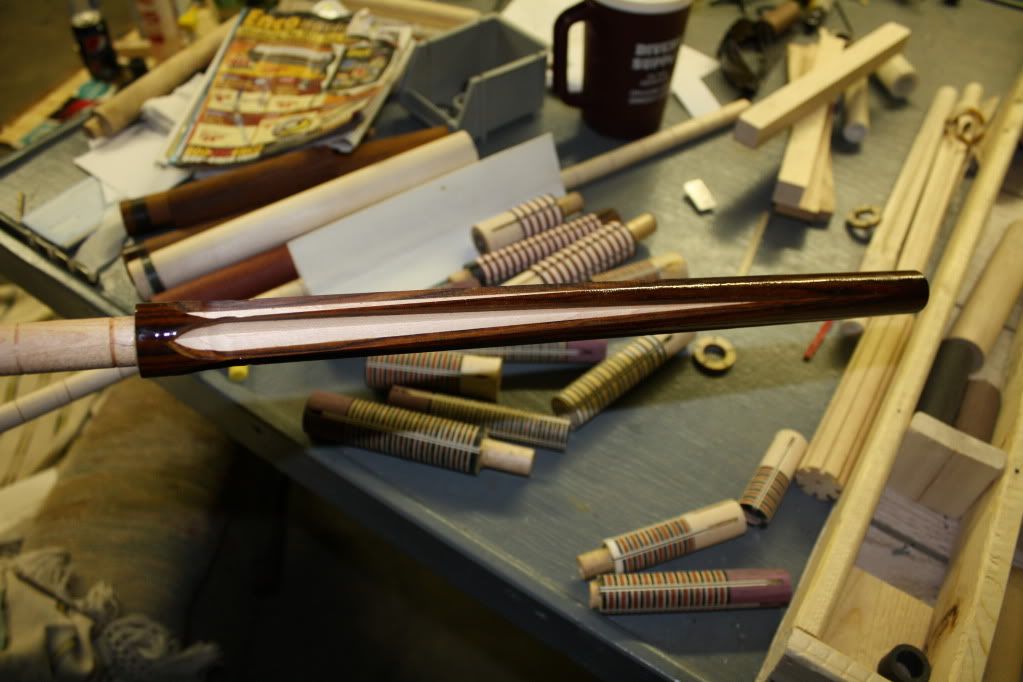
1- On the tulipwood forearm, are you sleeving a handle over the tenon and epoxy, or are you making a traditional A-Joint with that cue?
2- On the rosewood cue above, that looks like you'll put in the 5 points, then cut a flat face to the bottom of the points after filling the gap with epoxy. Correct?[/QUOTE]
Hi,
The Tulip cue forearm was cored at 1 3/8" and gorilla glued to the dowel, then tapered to .875 at the nose. After cutting the v grooves on the cored 14.5" forearm I glue in the veneered points. I fill in the end of the exposed v grooves with G-5 before I hold the dowel in the chuck and live center the nose and turn and face to 12".
The other cue shown is a full cored unit with the 5 V grooves cut before the veneered points are glued in.
Rick
5 point cored cue before the points are installed. Forearm is 14.5" long and will be turned and faced later to reveal the.025 gap between the points at the 12" position.

Last edited:
I did Ricks point coring method a few years ago and was quit surprised how great the cue played. this method will allow you to pin point the weight adding weight behind the pin and then in the butt end when your close to the last cut to achieve a good balance point. your on to some great cutting edge stuff Rick. I so look forward to collaborating our to shops to sell to over sees buyers. D Hill
Definitly some good looking cues there.
Hi,
I am of the same school of thought as Bob about eliminating the A-Joint on my 5 point veneered cues. I install weight pins behind my joint pin and have a weight pocket in the butt so that I can attain any weight and balance envelope I wish just before installing the pin. I still use the A-Joint on my 4 pointers as the geometry goes too close to the center of the core, Since I like wide points it is a trade off and I am too lazy to reindex and glue in the points early. I am making less 4 pointers these days.
Rick
5 Point Geometry built on a cored forearm glued to a 29" one piece dowel with no A-Joint. With a 5 point geometry I am able to obtain a repeatable .025 gap between the veneers at the bottom of the point section.

Before turning down the taper to remove the excess point and veneer material the cutter grooves are filled with epoxy. With the 5 point geometry there is no structural instability when facing the A-Joint area and turning the taper. (Tulip wood cue is 5 point, other 2 on left are 4 point with A-Joints)

The 5 point cues at the 12" area reveals a gap between the point veneers is a repeatable .025 gap due. A 14.5 inch forearm is is used to create the stability to produces this small gap at the bottom. After installing the points and turing the 2.5 off, the forearm is face at the 12" dimension.

Because 4 point cues threaten the centerline of the core making it unstable for turning and facing we use a traditional A-Joint connection with a 19" dowel screwed and glued to a previously core forearm. Cutting the groves, gluing the point veneers, and reindexing on the milling table is one way of perform the the 4 point geometry on the full core with the stability to face and turn afterword.

Traditional A-Joint section.

I have been coring my cues exclusively for the last 3 years and have beta tested many cues in the field. I have not had one cue develop a bump or produce any adverse buzz effect of any kind. I absolutely love Gorilla Glue and it's properties for cue making.!!!!!
I core everything.
Did the first cue in 1968.
Bill Stroud
Hi,
I bought my first custom cue in 1978 from Nick in Chicago at Marie's Golden Cue. It was a Ebony 4 point veneer JW beauty with an Ivory joint and ferrule. I did not know all of your cues were cored but I am glad to know that info about you coring everything.
Since it is good enough for the master, I think I will keep full coring everything as I don't want to trust a tenoned handle for the stability of the cue. If the handle moves a little, you lose the whole ball game. Too risky for me.
Rick G
Last edited:
